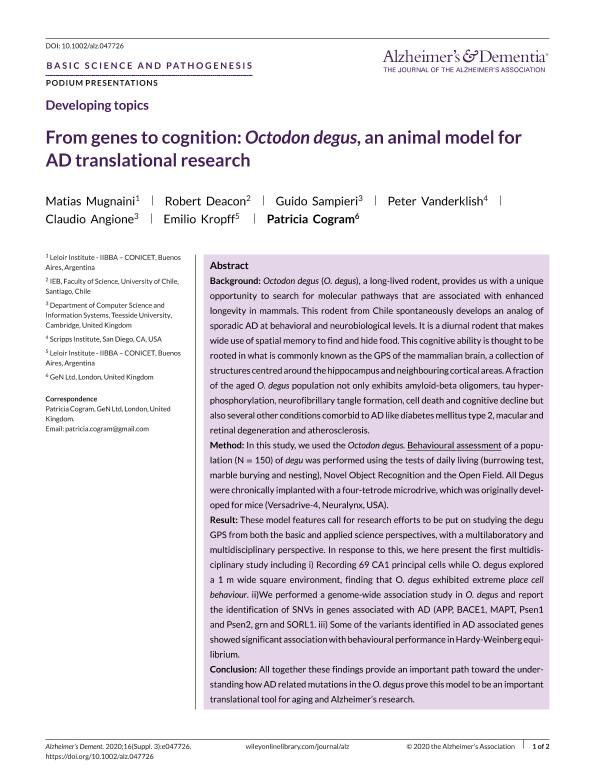Mostrar el registro sencillo del ítem
dc.contributor.author
Mugnaini, Matías

dc.contributor.author
Deacon, Robert
dc.contributor.author
Sampieri, Guido
dc.contributor.author
Vanderklish, Peter
dc.contributor.author
Angione, Claudio
dc.contributor.author
Kropff, Emilio

dc.contributor.author
Cogram, Patricia
dc.date.available
2021-08-23T15:57:28Z
dc.date.issued
2020-12
dc.identifier.citation
Mugnaini, Matías; Deacon, Robert; Sampieri, Guido; Vanderklish, Peter; Angione, Claudio; et al.; From genes to cognition: Octodon degus, an animal model for AD translational research; Willey; Alzheimers & Dementia; 16; S3; 12-2020; 1-2
dc.identifier.issn
1552-5260
dc.identifier.uri
http://hdl.handle.net/11336/138712
dc.description.abstract
Background: Octodon degus (O. degus), a long-lived rodent, provides us with a unique opportunity to search for molecular pathways that are associated with enhanced longevity in mammals. This rodent from Chile spontaneously develops an analog of sporadic AD at behavioral and neurobiological levels. It is a diurnal rodent that makes wide use of spatial memory to find and hide food. This cognitive ability is thought to be rooted in what is commonly known as the GPS of the mammalian brain, a collection of structures centred around the hippocampus and neighbouring cortical areas. A fraction of the aged O. degus population not only exhibits amyloid-beta oligomers, tau hyperphosphorylation, neurofibrillary tangle formation, cell death and cognitive decline but also several other conditions comorbid to AD like diabetes mellitus type 2, macular and retinal degeneration and atherosclerosis. Method: In this study, we used the Octodon degus. Behavioural assessment of a population (N = 150) of degu was performed using the tests of daily living (burrowing test, marble burying and nesting), Novel Object Recognition and the Open Field. All Degus were chronically implanted with a four-tetrode microdrive, which was originally developed for mice (Versadrive-4, Neuralynx, USA). Result: These model features call for research efforts to be put on studying the degu GPS from both the basic and applied science perspectives, with a multilaboratory and multidisciplinary perspective. In response to this, we here present the first multidisciplinary study including i) Recording 69 CA1 principal cells while O. degus explored a 1 m wide square environment, finding that O. degus exhibited extreme place cell behaviour. ii)We performed a genome-wide association study in O. degus and report the identification of SNVs in genes associated with AD (APP, BACE1, MAPT, Psen1 and Psen2, grn and SORL1. iii) Some of the variants identified in AD associated genes showed significant association with behavioural performance in Hardy-Weinberg equilibrium. Conclusion: All together these findings provide an important path toward the understanding how AD related mutations in the O. degus prove this model to be an important translational tool for aging and Alzheimer’s research.
dc.format
application/pdf
dc.language.iso
eng
dc.publisher
Willey
dc.rights
info:eu-repo/semantics/openAccess
dc.rights.uri
https://creativecommons.org/licenses/by-nc-sa/2.5/ar/
dc.subject
ALZHEIMER
dc.subject
OCTODON DEGUS
dc.subject
PLACE CELLS
dc.subject
SPATIAL MEMORY
dc.subject.classification
Otras Ciencias Médicas

dc.subject.classification
Otras Ciencias Médicas

dc.subject.classification
CIENCIAS MÉDICAS Y DE LA SALUD

dc.title
From genes to cognition: Octodon degus, an animal model for AD translational research
dc.type
info:eu-repo/semantics/article
dc.type
info:ar-repo/semantics/artículo
dc.type
info:eu-repo/semantics/publishedVersion
dc.date.updated
2021-08-20T19:38:18Z
dc.identifier.eissn
1552-5279
dc.journal.volume
16
dc.journal.number
S3
dc.journal.pagination
1-2
dc.journal.pais
Estados Unidos

dc.journal.ciudad
Amsterdam
dc.description.fil
Fil: Mugnaini, Matías. Consejo Nacional de Investigaciones Científicas y Técnicas. Oficina de Coordinación Administrativa Parque Centenario. Instituto de Investigaciones Bioquímicas de Buenos Aires. Fundación Instituto Leloir. Instituto de Investigaciones Bioquímicas de Buenos Aires; Argentina
dc.description.fil
Fil: Deacon, Robert. Universidad de Chile; Chile
dc.description.fil
Fil: Sampieri, Guido. Teesside University; Reino Unido
dc.description.fil
Fil: Vanderklish, Peter. The Scripps Research Institute; Estados Unidos
dc.description.fil
Fil: Angione, Claudio. Teesside University; Reino Unido
dc.description.fil
Fil: Kropff, Emilio. Consejo Nacional de Investigaciones Científicas y Técnicas. Oficina de Coordinación Administrativa Parque Centenario. Instituto de Investigaciones Bioquímicas de Buenos Aires. Fundación Instituto Leloir. Instituto de Investigaciones Bioquímicas de Buenos Aires; Argentina
dc.description.fil
Fil: Cogram, Patricia. No especifíca;
dc.journal.title
Alzheimers & Dementia

dc.relation.alternativeid
info:eu-repo/semantics/altIdentifier/url/https://onlinelibrary.wiley.com/doi/10.1002/alz.047726
dc.relation.alternativeid
info:eu-repo/semantics/altIdentifier/doi/http://dx.doi.org/10.1002/alz.047726
Archivos asociados
